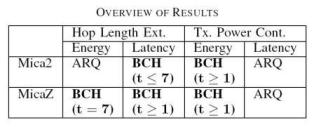Cross-Layer Analysis of Error Control in Wireless Sensor Networks,
M. C. Vuran and I. F. Akyildiz, in Proc. IEEE SECON '06, Reston, VA, September, 25-28, 2006.
 
|

|
Abstract:
Severe energy constraints and hence the low power communication
requirements amplify the significance of the energy efficient and
preferably cross-layer error control mechanisms in Wireless Sensor
Networks (WSN). In this paper, a cross-layer methodology for the
analysis of error control schemes in WSNs is presented such that the
effects of multi-hop routing and the broadcast nature of the
wireless channel are investigated. More specifically, the
cross-layer effects of routing, medium access and physical layers
are considered. This analysis enables a comprehensive comparison of
forward error correction (FEC) and automatic repeat request (ARQ) in
WSNs.
FEC schemes improve the error resiliency compared to ARQ. In a
multi-hop network, this improvement can be exploited by reducing the
transmit power (\emph{transmit power control}) or by constructing
longer hops (\emph{hop length extension}), which can be achieved
through channel-aware routing protocols. The results of our analysis
reveal that for certain FEC codes, the hop length extension
decreases both the energy consumption and the end-to-end latency
subject to a target PER compared to ARQ. Thus, FEC codes can be
regarded as an important candidate for delay sensitive traffic in
WSNs. On the other hand, transmit power control results in
significant savings in energy consumption at the cost of increased
latency. Moreover, the cases where ARQ outperforms FEC codes are
indicated for various end-to-end distance and target PER values.
|

